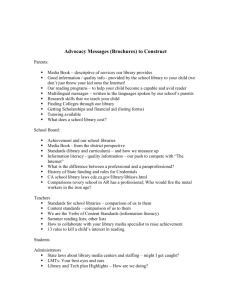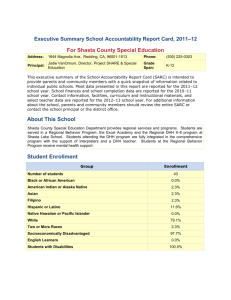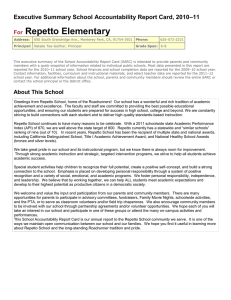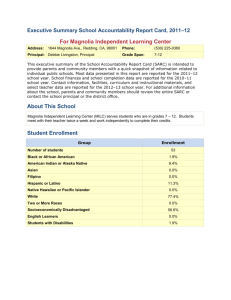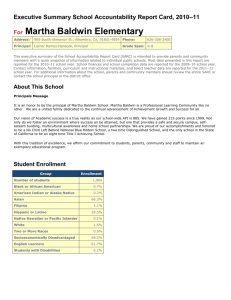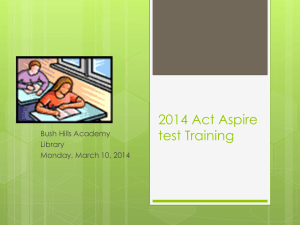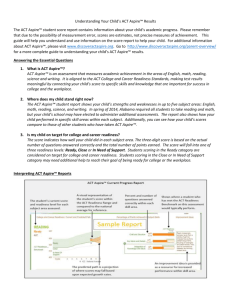English - Oakland Unified School District
advertisement
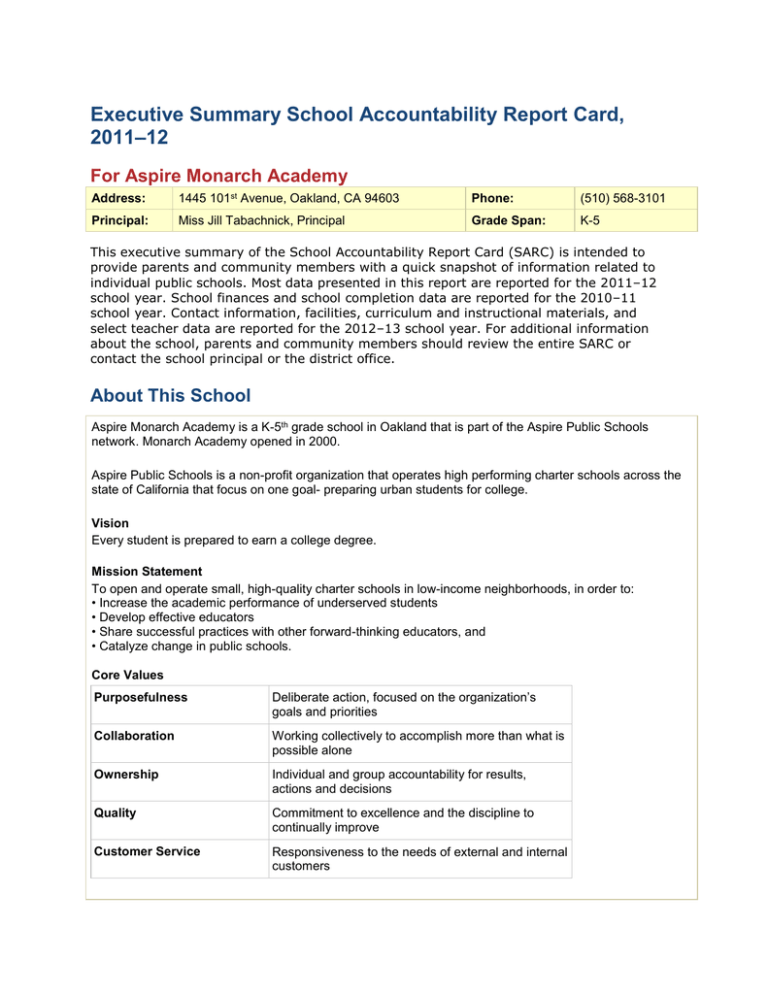
Executive Summary School Accountability Report Card, 2011–12 For Aspire Monarch Academy Address: 1445 101st Avenue, Oakland, CA 94603 Phone: (510) 568-3101 Principal: Miss Jill Tabachnick, Principal Grade Span: K-5 This executive summary of the School Accountability Report Card (SARC) is intended to provide parents and community members with a quick snapshot of information related to individual public schools. Most data presented in this report are reported for the 2011–12 school year. School finances and school completion data are reported for the 2010–11 school year. Contact information, facilities, curriculum and instructional materials, and select teacher data are reported for the 2012–13 school year. For additional information about the school, parents and community members should review the entire SARC or contact the school principal or the district office. About This School Aspire Monarch Academy is a K-5th grade school in Oakland that is part of the Aspire Public Schools network. Monarch Academy opened in 2000. Aspire Public Schools is a non-profit organization that operates high performing charter schools across the state of California that focus on one goal- preparing urban students for college. Vision Every student is prepared to earn a college degree. Mission Statement To open and operate small, high-quality charter schools in low-income neighborhoods, in order to: • Increase the academic performance of underserved students • Develop effective educators • Share successful practices with other forward-thinking educators, and • Catalyze change in public schools. Core Values Purposefulness Deliberate action, focused on the organization’s goals and priorities Collaboration Working collectively to accomplish more than what is possible alone Ownership Individual and group accountability for results, actions and decisions Quality Commitment to excellence and the discipline to continually improve Customer Service Responsiveness to the needs of external and internal customers Monarch Academy is a safe, caring, academically rigorous and inspiring learning environment where students develop the skills, knowledge and traits to become college-educated leaders in their communities. The School’s mission is to provide all students with an exceptional education that will allow them to excel inside and outside the classroom. The School seeks to achieve this mission by providing students a rigorous core curriculum, a well-trained staff, high standards and expectations, extended instructional hours and support, personalized learning opportunities, and early access to college-preparatory experiences. By ensuring students become voracious, self-motivated, competent and lifelong learners, the School will prepare them not only for college but also for the 21st Century world. Student Enrollment Group Enrollment Number of students 384 Black or African American 6.3% American Indian or Alaska Native 0.0% Asian 0.5% Filipino 0.0% Hispanic or Latino 91.9% Native Hawaiian or Pacific Islander 0.8% White 0.3% Two or More Races 0.3% Socioeconomically Disadvantaged 94.0% English Learners 88.3% Students with Disabilities 4.2% Teachers Indicator Teachers Teachers with full credential 19 Teachers without full credential 0 Teachers Teaching Outside Subject Area of Competence 0 Misassignments of Teachers of English Learners 1 Total Teacher Misassignments 1 Student Performance Subject Students Proficient and Above on STAR* Program Results English-Language Arts 46% Mathematics 61% Science 7% History-Social Science 0% *Standardized Testing and Reporting Program assessments used for accountability purposes include the California Standards Tests, the California Modified Assessment, and the California Alternate Performance Assessment. Academic Progress* Indicator Result 2012 Growth API Score (from 2012 Growth API Report) 773 Statewide Rank (from 2011 Base API Report) 4 Met All 2012 AYP Requirements no Number of AYP Criteria Met Out of the Total Number of Criteria Possible 2012–13 Program Improvement Status (PI Year) Met 9 of 17 Year 1 *The Academic Performance Index is required under state law. Adequate Yearly Progress is required by federal law. School Facilities Summary of Most Recent Site Inspection Monarch Academy is located at 1445 101st Avenue in Oakland, CA. The facility inspection was completed and no repairs were discovered at the time. Overall, the facility was found to be in good condition. Repairs Needed None needed at this time. Corrective Actions Taken or Planned None needed at this time. Curriculum and Instructional Materials Core Curriculum Area Pupils Who Lack Textbooks and Instructional Materials Reading/Language Arts 0% Mathematics 0% Science 0% History-Social Science 0% Foreign Language NA Health NA Visual and Performing Arts NA Science Laboratory Equipment (grades 9-12) NA School Finances Level Expenditures Per Pupil (Unrestricted Sources Only) School Site $9,082.87 District State $5,455 School Completion Indicator Result Graduation Rate (if applicable) NA Postsecondary Preparation Measure Percent Pupils Who Completed a Career Technical Education Program and Earned a High School Diploma NA Graduates Who Completed All Courses Required for University of California or California State University Admission NA School Accountability Report Card Reported Using Data from the 2011–12 School Year Published During 2012–13 Every school in California is required by state law to publish a School Accountability Report Card (SARC), by February 1 of each year. The SARC contains information about the condition and performance of each California public school. For more information about SARC requirements, see the California Department of Education (CDE) SARC Web page at http://www.cde.ca.gov/ta/ac/sa/. For additional information about the school, parents and community members should contact the school principal or the district office. I. Data and Access Ed-Data Partnership Web Site Ed-Data is a partnership of the CDE, EdSource, and the Fiscal Crisis and Management Assistance Team (FCMAT) that provides extensive financial, demographic, and performance information about California’s public kindergarten through grade twelve school districts and schools. DataQuest DataQuest is an online data tool located on the CDE DataQuest Web page at http://dq.cde.ca.gov/dataquest/ that contains additional information about this school and comparisons of the school to the district, the county, and the state. Specifically, DataQuest is a dynamic system that provides reports for accountability (e.g., state Academic Performance Index [API], federal Adequate Yearly Progress [AYP]), test data, enrollment, high school graduates, dropouts, course enrollments, staffing, and data regarding English learners. Internet Access Internet access is available at public libraries and other locations that are publicly accessible (e.g., the California State Library). Access to the Internet at libraries and public locations is generally provided on a first-come, first-served basis. Other use restrictions may include the hours of operation, the length of time that a workstation may be used (depending on availability), the types of software programs available on a workstation, and the ability to print documents. II. About This School Contact Information (School Year 2012–13) School District School Name Aspire Monarch Academy District Name Oakland Unified Street 1445 101st Avenue Phone Number (510) 879-8582 City, State, Zip Oakland, CA, 94603 Web Site www.ousd.k12.ca.us Phone Number (510) 568-3101 Superintendent Anthony Smith Principal Miss Jill Tabachnick, Principal E-mail Address E-mail Address delphine.sherman@aspirepublicschools.org CDS Code tony.smith@ousd.k12.ca.us 01612596117568 School Description and Mission Statement (School Year 2011–12) Aspire Monarch Academy is a K-5th grade school in Oakland that is part of the Aspire Public Schools network. Berkeley Maynard Academy opened in 2000. Aspire Public Schools is a non-profit organization that operates high performing charter schools across the state of California that focus on one goal- preparing urban students for college. Vision Every student is prepared to earn a college degree. Mission Statement To open and operate small, high-quality charter schools in low-income neighborhoods, in order to: • Increase the academic performance of underserved students • Develop effective educators • Share successful practices with other forward-thinking educators, and • Catalyze change in public schools. Core Values Purposefulness Deliberate action, focused on the organization’s goals and priorities Collaboration Working collectively to accomplish more than what is possible alone Ownership Individual and group accountability for results, actions and decisions Quality Commitment to excellence and the discipline to continually improve Customer Service Responsiveness to the needs of external and internal customers Monarch Academy is a safe, caring, academically rigorous and inspiring learning environment where students develop the skills, knowledge and traits to become college-educated leaders in their communities. The School’s mission is to provide all students with an exceptional education that will allow them to excel inside and outside the classroom. The School seeks to achieve this mission by providing students a rigorous core curriculum, a well-trained staff, high standards and expectations, extended instructional hours and support, personalized learning opportunities, and early access to college-preparatory experiences. By ensuring students become voracious, self-motivated, competent and lifelong learners, the School will prepare them not only for college but also for the 21st Century world. Opportunities for Parental Involvement (School Year 2011–12) Aspire Public Schools Guarantee to Parents: Demonstrated improvement in your child’s academic performance while attending an Aspire school; An open invitation to attend your child’s classes, plus several special scheduled Saturday classes; Easy, open and regular communication with teachers; The opportunity to rate the performance of teachers and the school through an annual, anonymous survey; and Eligibility to serve on the Advisory School Council to give input to the principal about school policies and procedures including hiring, evaluations, and safety programs. The School recognizes that children learn best when parents are engaged in their education. To help parents and guardians become great coaches for their children, and to invite parent participation in all aspects of school life, the School features: • Special Saturday classes: Scheduled at the beginning of the year, these three mandatory half-day sessions allow parents to attend school with their children. • Participation in school decision-making: Aspire includes parent representatives on the Advisory School Council and parent participation on the school’s Teacher Hiring Committee. • Opportunities to evaluate the School and its staff: Each spring, parents are asked to complete a survey evaluating the School, the principal, and their child’s teachers. The survey results are reviewed by the School staff as well as Aspire’s Home Office and are a factor in personnel decisions such as merit raises. • Regular communication about student learning and behavior: parents, students and teachers meet at least twice a year during Family Conferences to plan and assess the students’ learning progress and determine goals. In addition, the School staff will call parents regularly, both to provide positive reinforcement for academic growth and to inform parents when students make choices that do not match the School’s behavior and academic expectations. In addition, the School tries to create ways for families to invest some time in volunteer service each year. The School provides a variety of opportunities to match with different skills and interests. Examples include helping in classrooms, leading extra-curricular activities, coaching sports teams, assisting with event planning, attending field trips, attending ASC meetings, serving on parent committees, fundraising, and communicating with other parents. Advisory School Council Aspire encourages all groups to participate in and share responsibility for the educational process and educational results. The School has a recently-formed Advisory School Council (“ASC”), which meets occasionally as needed, and consists of teachers, parents, and the School Principal. The School’s ASC is intended to assist in developing School policies, engaging the community, and fulfilling certain compliance requirements related to state and federal funding. The ASC may make recommendations about issues related to the School and participate in reviewing parental and community concerns. If necessary, the principal is responsible for communicating all ASC policy recommendations to the Aspire Board of Directors. Student Enrollment by Grade Level (School Year 2011–12) Grade Level Number of Students Grade Level Number of Students Kindergarten 66 Grade 8 0 Grade 1 65 Ungraded Elementary 0 Grade 2 66 Grade 9 0 Grade 3 66 Grade 10 0 Grade 4 62 Grade 11 0 Grade 5 59 Grade 12 0 Grade 6 0 Ungraded Secondary Grade 7 0 Total Enrollment 0 384 Student Enrollment by Student Group (School Year 2011-12) Group Percent of Total Enrollment Black or African American 6.3% American Indian or Alaska Native 0.0% Asian 0.5% Filipino 0.0% Hispanic or Latino 91.9% Native Hawaiian or Pacific Islander 0.8% White 0.3% Two or More Races 0.3% Socioeconomically Disadvantaged 94.0% English Learners 88.3% Students with Disabilities 4.2% Average Class Size and Class Size Distribution (Elementary) Grade Level Avg. Class Size 2009–10 Number of Classes* 120 2132 33+ Avg. Class Size 2010–11 Number of Classes* 120 2132 33+ Avg. Class Size 2011–12 Number of Classes* 120 2132 33+ K 20 3 0 21.9 18 0 0 22.0 18 0 0 1 20 3 0 22.0 18 0 0 21.7 18 0 0 2 22 3 0 22.0 18 0 0 22.0 18 0 0 3 22 3 0 20.3 18 0 0 22.0 18 0 0 4 28.5 2 0 30.0 0 12 0 31.0 0 12 0 5 28.5 2 0 30.0 0 12 0 29.5 0 12 0 6 Other * Number of classes indicates how many classes fall into each size category (a range of total students per classroom). III. School Climate School Safety Plan (School Year 2011–12) It is the policy of Aspire Public Schools (“Aspire”) to strive for the highest safety standards and to provide a safe workplace for all employees and a safe school for all students. Aspire has developed a comprehensive Injury and Illness Prevention Program (“IIP Program”) to achieve this end. The goal of this program is to minimize the frequency and severity of employee and student accidents and to comply with the laws and regulations that pertain to our operations. The program has been designed to eliminate physical hazards from the work and school environment and train all employees in safe work practices. ASSIGNMENT OF RESPONSIBILITY Aspire Principals have the ultimate responsibility for the implementation and enforcement of the IIP Program at their school site. Aspire Office Managers are responsible for the record keeping and coordination of the safety training programs at their school site. Employees - It is the responsibility of all Aspire employees to bring any unsafe actions, practices, or conditions to the attention of his/her manager or supervisor. DISASTER PLANS Disaster plans are located in each classroom. Each plan is site and classroom specific and covers such disasters as fire safety, earthquake safety, flood, severe weather warnings, electrical failure, gas line problems, water main breaks, water contamination, chemical spills, lockdown/shooting incidents, bomb threats, explosions, and intruders. The school safety plan was reviewed and updated in July 2010. The school safety plan was presented and discussed with faculty on July 26, 2010. Suspensions and Expulsions Rate* School 2009–10 School 2010–11 School 2011–12 District 2009–10 District 2010–11 Suspensions 0.0% 15.0% 17.7% 14.4 ND Expulsions 0.0% 0.0% 0.0% 0.1 ND District 2011–12 * The rate of suspensions and expulsions is calculated by dividing the total number of incidents by the total enrollment. IV. School Facilities School Facility Conditions and Planned Improvements (School Year 2012–13) Monarch Academy is located at 1445 101st Avenue in Oakland, CA. The site inspection was completed and there were no repair discoveries made at the time of the inspection. The facilities were determined to be in good condition. School Facility Good Repair Status (School Year 2012–13) Repair Status System Inspected Exemplary Good Systems: Gas Leaks, Mechanical/HVAC, Sewer Fair X Interior: Interior Surfaces X Cleanliness: Overall Cleanliness, Pest/ Vermin Infestation X Electrical: Electrical Restrooms/Fountains: Restrooms, Sinks/ Fountains X Safety: Fire Safety, Hazardous Materials X Structural: Structural Damage, Roofs X External: Playground/School Grounds, Windows/ Doors/Gates/Fences X Poor Repair Needed and Action Taken or Planned Overall Rating X Note: Cells shaded in black do not require data. V. Teachers Teacher Credentials Teachers School 2009–10 School 2010–11 School 2011–12 19 19 19 Without Full Credential 1 1 0 Teaching Outside Subject Area of Competence (with full credential) 1 1 With Full Credential District 2011–12 0 Teacher Misassignments and Vacant Teacher Positions Indicator 2010–11 2011–12 2012–13 Misassignments of Teachers of English Learners 0 1 0 Total Teacher Misassignments* 0 1 0 Vacant Teacher Positions 0 0 0 Note: “Misassignments” refers to the number of positions filled by teachers who lack legal authorization to teach that grade level, subject area, student group, etc. * Total Teacher Misassignments includes the number of Misassignments of Teachers of English Learners. Core Academic Classes Taught by Highly Qualified Teachers (School Year 2011–12) The Federal Elementary and Secondary Education Act (ESEA), also known as No Child Left Behind (NCLB), requires that core academic subjects be taught by Highly Qualified Teachers, defined as having at least a bachelor’s degree, an appropriate California teaching credential, and demonstrated core academic subject area competence. For more information, see the CDE Improving Teacher and Principal Quality Web page at: http://www.cde.ca.gov/nclb/sr/tq/ Location of Classes Percent of Classes In Core Academic Subjects Taught by Highly Qualified Teachers Percent of Classes In Core Academic Subjects Not Taught by Highly Qualified Teachers This School 100% 0% All Schools in District 100% 0% 0% 0% High-Poverty Schools in District Low-Poverty Schools in District 0% 0% Note: High-poverty schools are defined as those schools with student eligibility of approximately 40 percent or more in the free and reduced price meals program. Low-poverty schools are those with student eligibility of approximately 25 percent or less in the free and reduced price meals program. VI. Support Staff Academic Counselors and Other Support Staff (School Year 2011–12) Number of FTE* Assigned to School Title Average Number of Students per Academic Counselor Academic Counselor Counselor (Social/Behavioral or Career Development) .5 Library Media Teacher (librarian) 1.0 Library Media Services Staff (paraprofessional) Psychologist .3 Social Worker Nurse Speech/Language/Hearing Specialist .3 Resource Specialist (non-teaching) .9 Other Note: Cells shaded in black do not require data. * One Full-Time Equivalent (FTE) equals one staff member working full-time; one FTE could also represent two staff members who each work 50 percent of full-time. VII. Curriculum and Instructional Materials Quality, Currency, Availability of Textbooks and Instructional Materials (School Year 2012–13) This section describes whether the textbooks and instructional materials used at the school are from the most recent adoption; whether there are sufficient textbooks and instruction materials for each student; and information about the school’s use of any supplemental curriculum or non-adopted textbooks or instructional materials. Year and month in which data were collected: ____________________ Core Curriculum Area Reading/Language Arts Textbooks and instructional materials/year of adoption K-3 Open Court Phonics Scholastic Leveled Library From most recent adoption? Yes Percent students lacking own assigned copy 0% Lucy Calkins Writing Units Mathematics Harcourt Math Yes 0% Science NA NA NA History-Social Science History Alive! Yes 0% Foreign Language NA NA NA Health NA NA NA Visual and Performing Arts NA NA Science Laboratory Equipment (grades 9-12) NA NA NA NA VIII. School Finances Expenditures Per Pupil and School Site Teacher Salaries (Fiscal Year 2010–11) Level School Site Total Expenditures Per Pupil Expenditures Per Pupil (Supplemental / Restricted) $9,082.87 $1,677.69 Expenditures Per Pupil (Basic / Unrestricted) $7,405.18 District Average Teacher Salary $49,466 $54,035 Percent Difference – School Site and District State -8.46 $5,455 $68,835 Percent Difference – School Site and State -28.14 Note: Cells shaded in black do not require data. Supplemental/Restricted expenditures come from money whose use is controlled by law or by a donor. Money that is designated for specific purposes by the district or governing board is not considered restricted. Basic/unrestricted expenditures are from money whose use, except for general guidelines, is not controlled by law or by a donor. For detailed information on school expenditures for all districts in California, see the CDE Current Expense of Education & Per-pupil Spending Web page at http://www.cde.ca.gov/ds/fd/ec/. For information on teacher salaries for all districts in California, see the CDE Certificated Salaries & Benefits Web page at http://www.cde.ca.gov/ds/fd/cs/. To look up expenditures and salaries for a specific school district, see the Ed-Data Web site at: http://www.ed-data.org. Types of Services Funded (Fiscal Year 2011–12) NA Teacher and Administrative Salaries (Fiscal Year 2010–11) Category District Amount State Average For Districts In Same Category Beginning Teacher Salary $39,456 $41,455 Mid-Range Teacher Salary $54,328 $66,043 Highest Teacher Salary $70,934 $85,397 Average Principal Salary (Elementary) $84,669 $106,714 Average Principal Salary (Middle) $85,411 $111,101 Average Principal Salary (High) $86,249 $121,754 $265,000 $223,357 29.00% 39.00% 7.00% 5.00% Superintendent Salary Percent of Budget for Teacher Salaries Percent of Budget for Administrative Salaries Note: For detailed information on salaries, see the CDE Certificated Salaries & Benefits Web page at http://www.cde.ca.gov/ds/fd/cs/. IX. Student Performance Standardized Testing and Reporting Program The Standardized Testing and Reporting (STAR) Program consists of several key components, including: California Standards Tests (CSTs), which include English-language arts (ELA) and mathematics in grades two through eleven; science in grades five, eight, and nine through eleven; and history-social science in grades eight, and nine through eleven. California Modified Assessment (CMA), an alternate assessment that is based on modified achievement standards in ELA for grades three through eleven; mathematics for grades three through seven, Algebra I, and Geometry; and science in grades five and eight, and Life Science in grade ten. The CMA is designed to assess those students whose disabilities preclude them from achieving grade-level proficiency on an assessment of the California content standards with or without accommodations. California Alternate Performance Assessment (CAPA), includes ELA and mathematics in grades two through eleven, and science for grades five, eight, and ten. The CAPA is given to those students with significant cognitive disabilities whose disabilities prevent them from taking either the CSTs with accommodations or modifications or the CMA with accommodations. The assessments under the STAR Program show how well students are doing in relation to the state content standards. On each of these assessments, student scores are reported as performance levels. For detailed information regarding the STAR Program results for each grade and performance level, including the percent of students not tested, see the CDE STAR Results Web site at http://star.cde.ca.gov. Standardized Testing and Reporting Results for All Students – Three-Year Comparison Percent of Students Scoring at Proficient or Advanced (meeting or exceeding the state standards) Subject School District State 2009– 10 2010– 11 2011– 12 2009– 10 2010– 11 2011– 12 2009– 10 2010– 11 2011– 12 EnglishLanguage Arts 55% 47% 46% 43% 45% 47% 52% 54% 56% Mathematics 76% 64% 61% 44% 46% 46% 48% 50% 51% Science 30% 15% 7% 41% 46% 49% 54% 57% 60% HistorySocial Science 0% 0% 0% 27% 32% 31% 44% 48% 49% Note: Scores are not shown when the number of students tested is ten or less, either because the number of students in this category is too small for statistical accuracy or to protect student privacy. Standardized Testing and Reporting Results by Student Group – Most Recent Year Percent of Students Scoring at Proficient or Advanced Group EnglishLanguage Arts Mathematics Science History- Social Science All Students in the LEA 47% 46% 49% 31% All Students at the School 46% 61% 7% 0% Male 45% 59% 11% 0% Female 46% 63% 4% 0% Black or African American 52% 43% 0% 0% 0% 0% 0% 0% 45% 62% 8% 0% Native Hawaiian or Pacific Islander 0% 0% 0% 0% White 0% 0% 0% 0% Two or More Races 0% 0% 0% 0% American Indian or Alaska Native Asian Filipino Hispanic or Latino Socioeconomically Disadvantaged 46% 62% 6% 0% English Learners 30% 50% 5% 0% Students with Disabilities 20% 40% 0% 0% Students Receiving Migrant Education Services Note: Scores are not shown when the number of students tested is ten or less, either because the number of students in this category is too small for statistical accuracy or to protect student privacy. California High School Exit Examination The California High School Exit Examination (CAHSEE) is primarily used as a graduation requirement. However, the grade ten results of this exam are also used to establish the percentages of students at three proficiency levels (not proficient, proficient, or advanced) in ELA and mathematics to compute AYP designations required by the federal ESEA, also known as NCLB. For detailed information regarding CAHSEE results, see the CDE CAHSEE Web site at http://cahsee.cde.ca.gov/. California High School Exit Examination Results for All Grade Ten Students – Three-Year Comparison (if applicable) Percent of Students Scoring at Proficient or Advanced School Subject 2009– 10 2010– 11 District 2011– 12 State 2009– 10 2010– 11 2011– 12 2009– 10 2010– 11 2011– 12 EnglishLanguage Arts 35% 40% 39% 54% 59% 56% Mathematics 36% 40% 44% 54% 56% 58% Note: Scores are not shown when the number of students tested is ten or less, either because the number of students in this category is too small for statistical accuracy or to protect student privacy. California High School Exit Examination Grade Ten Results by Student Group – Most Recent Year (if applicable) English-Language Arts Group All Students in the LEA All Students at the School Mathematics Not Proficient Proficient Advanced Not Proficient Proficient Advanced 61% 18% 22% 56% 28% 16% NA NA NA NA NA NA Male NA NA NA NA NA NA Female NA NA NA NA NA NA Black or African American NA NA NA NA NA NA American Indian or Alaska Native NA NA NA NA NA NA Asian NA NA NA NA NA NA Filipino NA NA NA NA NA NA Hispanic or Latino NA NA NA NA NA NA Native Hawaiian or Pacific Islander NA NA NA NA NA NA White NA NA NA NA NA NA Two or More Races NA NA NA NA NA NA Socioeconomically Disadvantaged NA NA NA NA NA NA English Learners NA NA NA NA NA NA Students with Disabilities NA NA NA NA NA NA Students Receiving Migrant Education Services NA NA NA NA NA NA Note: Scores are not shown when the number of students tested is ten or less, either because the number of students in this category is too small for statistical accuracy or to protect student privacy. California Physical Fitness Test Results (School Year 2011–12) The California Physical Fitness Test (PFT) is administered to students in grades five, seven, and nine only. This table displays by grade level the percent of students meeting the fitness standards for the most recent testing period. For detailed information regarding this test, and comparisons of a school’s test results to the district and state, see the CDE PFT Web page at http://www.cde.ca.gov/ta/tg/pf/. Percent of Students Meeting Fitness Standards Grade Level Four of Six Standards Five of Six Standards Six of Six Standards 5 19.00% 13.80% 3.40% 7 0.00% 0.00% 0.00% 9 0.00% 0.00% 0.00% Note: Scores are not shown when the number of students tested is ten or less, either because the number of students in this category is too small for statistical accuracy or to protect student privacy. X. Accountability Academic Performance Index The Academic Performance Index (API) is an annual measure of state academic performance and progress of schools in California. API scores range from 200 to 1,000, with a statewide target of 800. For detailed information about the API, see the CDE API Web page at http://www.cde.ca.gov/ta/ac/ap/. Academic Performance Index Ranks – Three-Year Comparison This table displays the school’s statewide and similar schools’ API ranks. The statewide API rank ranges from 1 to 10. A statewide rank of 1 means that the school has an API score in the lowest ten percent of all schools in the state, while a statewide rank of 10 means that the school has an API score in the highest ten percent of all schools in the state. The similar schools API rank reflects how a school compares to 100 statistically matched “similar schools.” A similar schools rank of 1 means that the school’s academic performance is comparable to the lowest performing ten schools of the 100 similar schools, while a similar schools rank of 10 means that the school’s academic performance is better than at least 90 of the 100 similar schools. API Rank 2009 Statewide Similar Schools 2010 2011 5 7 4 10 10 7 Academic Performance Index Growth by Student Group – Three-Year Comparison Group All Students at the School Actual API Change 2009–10 Actual API Change 2010–11 Actual API Change 2011–12 52 -38 -14 53 -39 -9 Socioeconomically Disadvantaged 53 -34 -12 English Learners 52 -49 -5 Black or African American American Indian or Alaska Native Asian Filipino Hispanic or Latino Native Hawaiian or Pacific Islander White Two or More Races Students with Disabilities Note: “N/D” means that no data were available to the CDE or LEA to report. “B” means the school did not have a valid API Base and there is no Growth or target information. “C” means the school had significant demographic changes and there is no Growth or target information. Academic Performance Index Growth by Student Group – 2012 Growth API Comparison This table displays, by student group, the number of students included in the API and the 2012 Growth API at the school, LEA, and state level. 2012 Growth API Group All Students at the School Black or African American Number of Students School Number of Students LEA Number of Students State 251 773 25,919 730 4,664,264 788 21 749 8,018 655 313,201 710 American Indian or Alaska Native 0 91 702 31,606 742 Asian 2 4,029 826 404,670 905 Filipino 0 243 808 124,824 869 9,975 701 2,425,230 740 Hispanic or Latino 220 Native Hawaiian or Pacific Islander 2 309 675 26,563 775 White 1 2,458 900 1,221,860 853 Two or More Races 1 529 869 88,428 849 Socioeconomically Disadvantaged 228 776 16,312 692 2,779,680 737 English Learners 209 769 10,835 701 1,530,297 716 21 643 2,741 558 530,935 607 Students with Disabilities 775 Adequate Yearly Progress The federal ESEA requires that all schools and districts meet the following Adequate Yearly Progress (AYP) criteria: Participation rate on the state’s standards-based assessments in ELA and mathematics Percent proficient on the state’s standards-based assessments in ELA and mathematics API as an additional indicator Graduation rate (for secondary schools) For detailed information about AYP, including participation rates and percent proficient results by student group, see the CDE AYP Web page at http://www.cde.ca.gov/ta/ac/ay/. Adequate Yearly Progress Overall and by Criteria (School Year 2011–12) AYP Criteria Made AYP Overall School District No No Met Participation Rate - English-Language Arts Yes Yes Met Participation Rate - Mathematics Yes Yes Met Percent Proficient - English-Language Arts No No Met Percent Proficient - Mathematics No No Met API Criteria Yes Yes Met Graduation Rate N/A No Federal Intervention Program (School Year 2012–13) Schools and districts receiving federal Title I funding enter Program Improvement (PI) if they do not make AYP for two consecutive years in the same content area (ELA or mathematics) or on the same indicator (API or graduation rate). After entering PI, schools and districts advance to the next level of intervention with each additional year that they do not make AYP. For detailed information about PI identification, see the CDE PI Status Determinations Web page: http://www.cde.ca.gov/ta/ac/ay/tidetermine.asp. Indicator Program Improvement Status First Year of Program Improvement Year in Program Improvement School District In PI In PI 2012-2013 2004-2005 Year 1 Year 3 Number of Schools Currently in Program Improvement 84 Percent of Schools Currently in Program Improvement 63.6% Note: Cells shaded in black do not require data. XI. School Completion and Postsecondary Preparation Admission Requirements for California’s Public Universities University of California Admission requirements for the University of California (UC) follow guidelines set forth in the Master Plan, which requires that the top one-eighth of the state’s high school graduates, as well as those transfer students who have successfully completed specified college course work, be eligible for admission to the UC. These requirements are designed to ensure that all eligible students are adequately prepared for University-level work. For general admissions requirements, please visit the UC Admissions Information Web page at http://www.universityofcalifornia.edu/admissions/. (Outside source) California State University Eligibility for admission to the California State University (CSU) is determined by three factors: Specific high school courses Grades in specified courses and test scores Graduation from high school Some campuses have higher standards for particular majors or students who live outside the local campus area. Because of the number of students who apply, a few campuses have higher standards (supplementary admission criteria) for all applicants. Most CSU campuses have local admission guarantee policies for students who graduate or transfer from high schools and colleges that are historically served by a CSU campus in that region. For admission, application, and fee information see the CSU Web page at http://www.calstate.edu/admission/admission.shtml. (Outside source) Dropout Rate and Graduation Rate School Indicator 2008– 09 District 2009– 10 2010– 11 Dropout Rate NA Graduation Rate NA 2008– 09 State 2009– 10 2010– 11 NA 32.1 NA 55.16 2008– 09 2009– 10 2010– 11 27.3 16.6 14.4 59.14 74.72 76.26 Note: Cells shaded in black do not require data. Completion of High School Graduation Requirements This table displays, by student group, the percent of students who began the 2011–12 school year in grade twelve and were a part of the school’s most recent graduating class, meeting all state and local graduation requirements for grade twelve completion, including having passed both the ELA and mathematics portions of the CAHSEE or received a local waiver or state exemption. Graduating Class of 2012 Group School District State NA N/D N/D Black or African American N/D N/D American Indian or Alaska Native N/D N/D Asian N/D N/D Filipino N/D N/D Hispanic or Latino N/D N/D Native Hawaiian or Pacific Islander N/D N/D White N/D N/D Two or More Races N/D N/D Socioeconomically Disadvantaged N/D N/D English Learners N/D N/D Students with Disabilities N/D N/D All Students Note: “N/D” means that no data were available to the CDE or LEA to report. Courses for University of California and/or California State University Admission UC/CSU Course Measure Percent 2011-12 Students Enrolled in Courses Required for UC/CSU Admission NA 2010-11 Graduates Who Completed All Courses Required for UC/CSU Admission NA Advanced Placement Courses (School Year 2011–12) Subject Number of AP Courses Offered* Percent of Students In AP Courses Computer Science NA English NA Fine and Performing Arts NA Foreign Language NA Mathematics NA Science NA Social Science NA All courses NA NA Note: Cells shaded in black do not require data. *Where there are student course enrollments. XII. Instructional Planning and Scheduling Professional Development This section provides information on the annual number of school days dedicated to staff development for the most recent three-year period. Aspire is committed to the professional development of all of its team members. Once teachers are hired, Aspire invests in their continued professional development. Teachers new to Aspire participate in 1-2 weeks of summer training to build classroom management skills, increase their capacity to plan meaningful and engaging lessons, and practice specific Instructional Guidelines that are core to the Aspire education program, and then receive on-going coaching support from a variety of individuals to reinforce and deepen their training. The School Principal, in his/her capacity as instructional leader, provides on-site coaching to all teachers. Teachers are organized into teams, led by an experienced “lead teacher” who has the skills to mentor others. Teachers are given time during the regular school day to collaborate and support each other to reach the Schools’ and individual students’ learning goals, including common preparation time through use of Integral Subjects (e.g. music, Spanish) and early release days on Fridays. Aspire also has instructional coaches who travel between school sites to provide additional support, give one on-one consultation, and conduct school-based professional development sessions. Instructional coaches also guide experienced educators in their application for certification from the National Board for Professional Teaching Standards. In addition, Aspire conducts one or two regional training sessions in areas identified as system-wide weaknesses based on the prior year’s STAR results. Aspire Monarch Academy Oakland Unified School Accountability Report Card, 2011-2012 Provided by the Ed-Data Partnership For more information visit www.ed-data.org
